Articular bone on:
[Wikipedia]
[Google]
[Amazon]
 The articular bone is part of the lower jaw of most
The articular bone is part of the lower jaw of most
 The articular bone is part of the lower jaw of most
The articular bone is part of the lower jaw of most vertebrates
Vertebrates () are animals with a vertebral column (backbone or spine), and a cranium, or skull. The vertebral column surrounds and protects the spinal cord, while the cranium protects the brain.
The vertebrates make up the subphylum Vertebra ...
, including most jawed fish
Gnathostomata (; from Ancient Greek: (') 'jaw' + (') 'mouth') are jawed vertebrates. Gnathostome diversity comprises roughly 60,000 species, which accounts for 99% of all extant taxon, extant vertebrates, including all living bony fishes (bot ...
, amphibians
Amphibians are ectothermic, anamniote, anamniotic, tetrapod, four-limbed vertebrate animals that constitute the class (biology), class Amphibia. In its broadest sense, it is a paraphyletic group encompassing all Tetrapod, tetrapods, but excl ...
, birds
Birds are a group of warm-blooded vertebrates constituting the class (biology), class Aves (), characterised by feathers, toothless beaked jaws, the Oviparity, laying of Eggshell, hard-shelled eggs, a high Metabolism, metabolic rate, a fou ...
and various kinds of reptiles
Reptiles, as commonly defined, are a group of tetrapods with an ectothermic metabolism and Amniotic egg, amniotic development. Living traditional reptiles comprise four Order (biology), orders: Testudines, Crocodilia, Squamata, and Rhynchocepha ...
, as well as ancestral mammals
A mammal () is a vertebrate animal of the class Mammalia (). Mammals are characterised by the presence of milk-producing mammary glands for feeding their young, a broad neocortex region of the brain, fur or hair, and three middle e ...
.
Anatomy
In most vertebrates, the articular bone is connected to two other lower jaw bones, thesuprangular
The surangular or suprangular is a jaw bone found in most land vertebrates, except mammals. Usually in the back of the jaw, on the upper edge, it is connected to all other jaw bones: dentary, angular, splenial and articular. It is often a musc ...
and the angular. Developmentally, it originates from the embryonic mandibular cartilage. The most caudal portion of the mandibular cartilage ossifies to form the articular bone, while the remainder of the mandibular cartilage either remains cartilaginous or disappears.
In snakes
Insnakes
Snakes are elongated Limbless vertebrate, limbless reptiles of the suborder Serpentes (). Cladistically Squamata, squamates, snakes are ectothermic, amniote vertebrates covered in overlapping Scale (zoology), scales much like other members of ...
, the articular, surangular, and prearticular bones have fused to form the compound bone. The mandible is suspended from the quadrate bone and articulates at this compound bone.
Function
In amphibians and reptiles
In most tetrapods, the articular bone forms the lower portion of the jaw joint. The upper jaw articulates at thequadrate bone
The quadrate bone is a skull bone in most tetrapods, including amphibians, sauropsids ( reptiles, birds), and early synapsids.
In most tetrapods, the quadrate bone connects to the quadratojugal and squamosal bones in the skull, and forms up ...
.
In mammals
Inmammals
A mammal () is a vertebrate animal of the class Mammalia (). Mammals are characterised by the presence of milk-producing mammary glands for feeding their young, a broad neocortex region of the brain, fur or hair, and three middle e ...
, the articular bone evolves to form the malleus
The ''malleus'', or hammer, is a hammer-shaped small bone or ossicle of the middle ear. It connects with the incus, and is attached to the inner surface of the eardrum. The word is Latin for 'hammer' or 'mallet'. It transmits the sound vibra ...
, one of the mammalian ossicles
The ossicles (also called auditory ossicles) are three irregular bones in the middle ear of humans and other mammals, and are among the smallest bones in the human body. Although the term "ossicle" literally means "tiny bone" (from Latin ''ossi ...
of the middle ear. This is an apomorphy
In phylogenetics, an apomorphy (or derived trait) is a novel Phenotypic trait, character or character state that has evolution, evolved from its ancestral form (or Plesiomorphy and symplesiomorphy, plesiomorphy). A synapomorphy is an apomorphy sh ...
of the mammalian clade, and is used to determine the fossil transition to mammals. It is analogous to, but not homologous to the articular process
The articular process or zygapophysis ( + apophysis) of a vertebra is a projection of the vertebra that serves the purpose of fitting with an adjacent vertebra. The actual region of contact is called the ''articular facet''.Moore, Keith L. et al. ...
of the lower jaw
In jawed vertebrates, the mandible (from the Latin ''mandibula'', 'for chewing'), lower jaw, or jawbone is a bone that makes up the lowerand typically more mobilecomponent of the mouth (the upper jaw being known as the maxilla).
The jawbone i ...
.
After the loss of the quadrate-articular joint, the squamosal and dentary bones form the new jaw joint in mammals.
See also
*Evolution of mammalian auditory ossicles
The evolution of mammalian auditory ossicles was an evolutionary process that resulted in the formation of the mammalian middle ear, where the three middle ear bones or ossicles, namely the incus, malleus and stapes (a.k.a. "the anvil, hammer, and ...
References
Skull bones {{Vertebrate-anatomy-stub